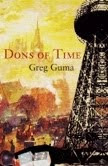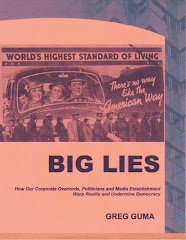Part 29 of Prisoners of the Real
In the Hopi language the distinction between past, present and future simply doesn't exist. Rather than distinguishing between tenses, Hopi concentrates on the validity of a statement – as fact, memory, expectation, or custom. Thus, there's no difference in this language between "he runs," "he is running" and "he ran." All are encompassed by wari, "running occur." An expectation is covered by warinki, roughly translated as "running occur I expect," which covers several tenses.
Hopi provides no general notion of time as a smooth flowing continuum proceeding at a specific rate. Rather than denoting categories of space and time, this language distinguishes the "manifest" – that is, accessibility to the senses – and the "unmanifest," including the future and the mental. Tenses are also irrelevant in Navaho, which instead emphasizes the type of activity.
Indo-European languages deal with both spatial and non-spatial relations through spatial metaphors such as duration, tendency, and intensity. Both a physical item and an idea, for example, can "falter." Balloons "swell," and so do thoughts and emotions. Both a person and a memory can "linger."
In Hopi, on the other hand, psychological metaphors are used to name physical things; the root meaning of "heart," for example, is "think" or "remember." While this language can describe all observable phenomena, the underlying metaphysics is entirely different, reflecting a mystical experience of oneness. Thus, Hopi and other languages provide alternative bases for valid descriptions of the universe without relying on the concepts of time and space.
In general, Indo-European languages obligate their users to distinguish between singular and plural, and to concretize and objectify the abstracts of the world. Reality is perceived as a complex of bodies and substances; non-spatial concepts are forced into binomial formulae. The objectified view of time is central to Newtonian physics, a view Einstein transcended in his theory. Although useful for the recording of history and the keeping of records, the notion of objectified time is oppressive when it promotes the assumption that time can be saved, that it is a finite object that runs out. Europeans, Americans, and the billions who live under the global influence of these languages measure standardized units of time and reward each other for the number of units worked, regardless of the differing subjective time experiences of each person. Unfortunately, this view of time also creates a feeling of monotony, with resultant behavioral effects.
Seeing life as expected and expecting existing patterns to continue leads to the sense that we are trapped. On the other hand, objectifying concepts can be helpful in a variety of creative experiences. In particular, the use of metaphors, through which objective qualities are attributed to subjective experiences, transfers qualities of spatial items to non-spatial concepts.
Or, as Hegel explained, in art the infinite becomes visible.
The importance of Whorf's hypothesis (see part 28) is not only the insight it provides into the diversity of linguistic systems and their impacts on categories of cognition. It also points to the very foundations of human knowledge. According to the classical, absolutist world view, the forms of space and time, and basic categories such as substance and causality, are universal. Physical science has used these categories to develop a system of knowledge that covers all phenomena and mental activities. However, modern science has for some time understood that this view is flawed. Euclidean space is only one form of geometry, and along with Newtonian time, doesn't always apply – particularly at the astronomical and atomic levels.
Time, according to relativity theory, is a coordinate in a four-dimensional system. And solid matter, says atomic physics, is actually a void interwoven by centers of energy. In quantum physics the determinism of classical physics is replaced by indeterminism. Obviously, the old categories have been modified. The absolute has become relative. Growing out of this change in scientific thinking is a realization that concepts concerning human relations and human nature must also be reconsidered.
In the language of the Wintu Indians, form is transient. Nature exists, and human beings can't affect it. They do not "come into being," but rather grow "out of the ground," and can influence their temporary, changing surroundings.
In contrast, English and other similar languages have led to the assumption that humans are separate from their environment, and controlled by external stimuli. The concept of separation from the environment is alien to Wintu, which recognizes individuality only as a manifestation in the consciousness of the speaker. In this world view, the idea of stimulus and response doesn't exist. The world is a mass in which each particular shares the qualities of the whole.
Ironically, the process of ever-increasing abstraction in the exact sciences is bringing us toward a sense of reality and the world quite consistent with the assumptions of Wintu and other non-European languages. Developments in many fields, all running in the same basic direction, are moving beyond the immediate sensory present into a region where the fundamental connections between all living things can at last be seen. A sense is emerging that life on Earth represents a unity, that damage at one point can have effects everywhere else, and that we are all responsible.
The outline of a new and holistic world view can already be seen. As quantum theory suggests, mind – the participator – formulates the proposition from which matter is derived. Energy manifests itself as transient particles, material forms which can't be isolated from the wholeness of the entire universe. In addition, individual universe constructions form each other, each connected to all others in constantly changing patterns. It is a self-organizing process, beginningless and endless.
As startling as this may sound, scientific discoveries suggest that all possible histories of the universe occur and interfere with each other. Regions of constructive interference, the path along which we can move with least disturbance, provide the "classical" history of the universe as we know it in our usual states of consciousness. But as Einstein realized and Wheeler subsequently stated, there is one more question: why does any individual particle jump into the instantaneous world line at a particular space-time coordinate? It's a question that physics alone cannot answer.
The notion of quantum probability, however, does suggest a source: the will of the participator, expressed through creative ideas. All conscious systems, regardless of their location, contribute to the total quantum potential. The character of each event is a gestalt property of the wholeness of the universe. The volitional activity may be either active or passive. According to psychic research, sets of subjective states are linked with changes in the pattern of behavior in the body. Passive volitional states may even reach outside the body, impressing a coherent pattern on the movement of elementary particles.
Such revolutionary ideas suggest a gradual coming together of two distinct and, until very recently, apparently opposite views of reality. As the physicist Wolfgang Pauli once noted, both views have been vital to the history of human thought, though no genuine reality corresponds to either. One is the idea of an objective world, pursuing its course in space and time independently of any observing subject. This, of course, is the view of most modern science. The other is the idea of the subject, experiencing the unity of the world without the limitation of objective reality. This is the view of much Asian mysticism.
In the 20th Century we moved from the pure scientific view to a point somewhere between the two, realizing along the way that our language may be holding us back. To continue the search, language itself will have to change.
Note: Thanks to Jo Schneiderman for assistance with comparative linguistic analysis.
Next: Rediscovering Dionysus
To read other chapters, go to Prisoners of the Real: An Odyssey
Subscribe to:
Post Comments (Atom)































No comments:
Post a Comment